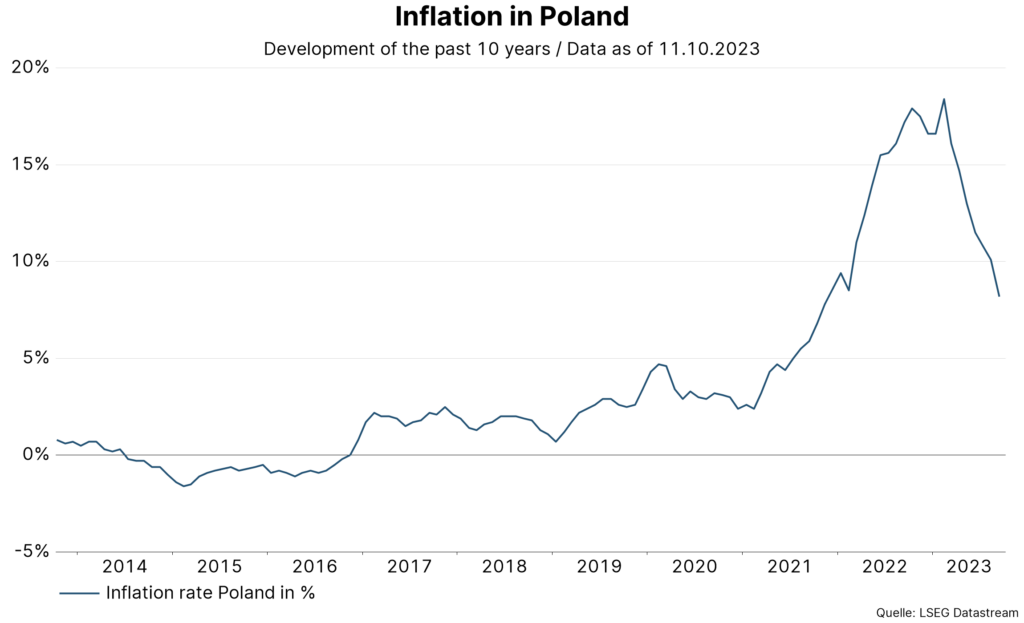Poland will be holding parliamentary elections on 15 October. While the national-conservative PiS won an absolute majority in the lower house of parliament in the last elections in 2019, this time the outcome is more open. Although the PiS (“Prawo i Sprawiedliwość”, english “law and justice”) is holding a clear lead in the polls with 36-38% of the vote and rising voter support, it falls short of an absolute majority.
This upward trend has come mainly at the expense of the far-right Confederation (10-12%), which is regarded as a potential government partner for the PiS after the elections. The moderate opposition bloc (Civic Platform PO (30%), Third Way (8-10%), The Left (5-8%)) has achieved largely stable results in the polls in recent weeks.
Election system favours bigger parties
The Polish electoral system for the lower house of parliament distributes seats according to a proportional list system that favours larger parties. A coalition must pass an 8% threshold to qualify, while the 5% threshold is relevant for a single party. The Left is running at these elections as one party and seems relatively certain to pass the 5% hurdle. By contrast, the Third Way is a coalition, and this alliance therefore has a harder time entering parliament.
The PiS is trying to score points in the election campaign with the distribution of generous social benefits and an anti-EU stance. Accordingly, it has made national defence and migration its main campaign issues. A success for the opposition PO at the elections, on the other hand, depends to a large degree on how strongly it can mobilise women voters in particular. The smaller parties/blocs suffer from the strong polarisation and cannot make any gains in the polls. All in all, the polls indicate a close result. Several government constellations are therefore within the realm of possibility for the new legislative period.
Will the expansive monetary policy be continued?
In our base-case scenario, the PiS leads a majority or minority government with the help of the Confederation. In such a case, we would expect the expansive monetary and fiscal policy to continue. However, it remains questionable how much of the election promises will be implemented. Fiscal consolidation is likely to slow down, with the budget deficit falling from 5.3% of GDP this year to only 4.5% of GDP in 2024. Moreover, the blocked EU funds from the Reconstruction and Resilience Facility and the EU budget 2021-27 are unlikely to arrive as early as next year.

Note: Past performance is not a reliable indicator for future performance.
EU money if the opposition wins
In the event of an opposition victory, we expect a positive reaction from the markets. The main reason for this is the expected release of EUR 77bn in cohesion funds from the EU budget 2021-27 and EUR 36bn in funds from the Reconstruction and Resilience Facility. Given the equally excessive election promises of both the PO and potential coalition partners, there is a high degree of uncertainty about the prospects for faster fiscal consolidation in 2024.
The composition of the central bank’s Monetary Policy Committee will only change in the medium term. The members appointed mainly by the old government would not be taking decisions nearly as “pro-government” as under a PiS government.
Conclusion
The parliamentary elections in Poland are taking place against the backdrop of a weakening economy. Interest rate hikes to combat inflation rates not seen since the 1990s and the global economic slowdown have had a negative impact on aggregate demand: Poland has not experienced a more significant drop in consumption since 1996.
Inflation rates, supported by electricity and fuel price cuts, have returned to single digits. This development will enable the Polish central bank to implement further interest rate cuts. At the same time, the rather expansive fiscal policy should put pressure on local government bond yields via high issue activity.
We envisage a substantial weakening of the zloty only if the combination of monetary and fiscal policy becomes too expansive or an increase in global risk aversion leads to a flight to safe havens. On the other hand, supported by a balanced current account, the zloty would benefit from an economic recovery or, due to its proximity, from an end to the war in Ukraine.
For a glossary of technical terms, please visit this link: Fund Glossary | Erste Asset Management
Legal note:
Prognoses are no reliable indicator for future performance.

